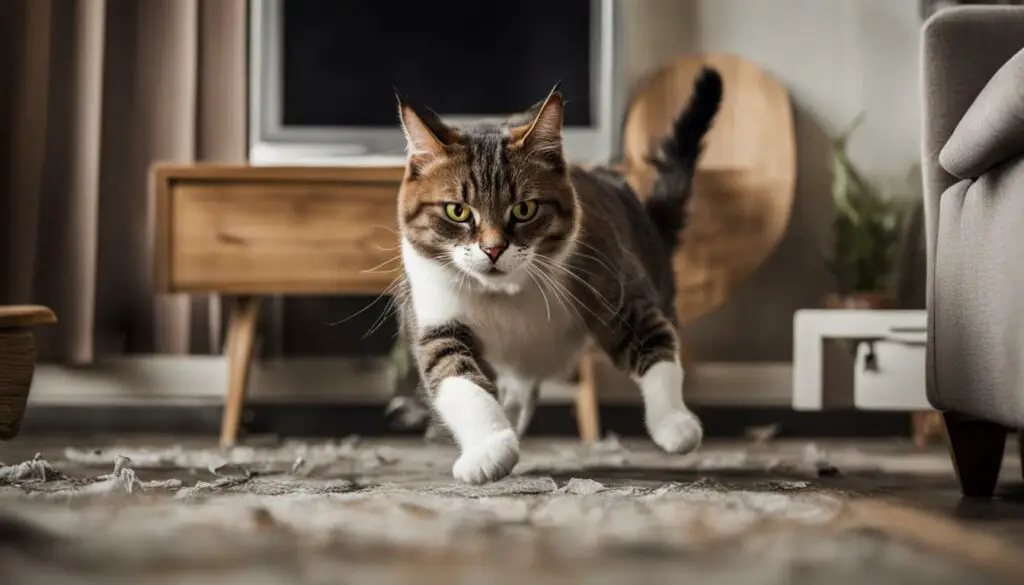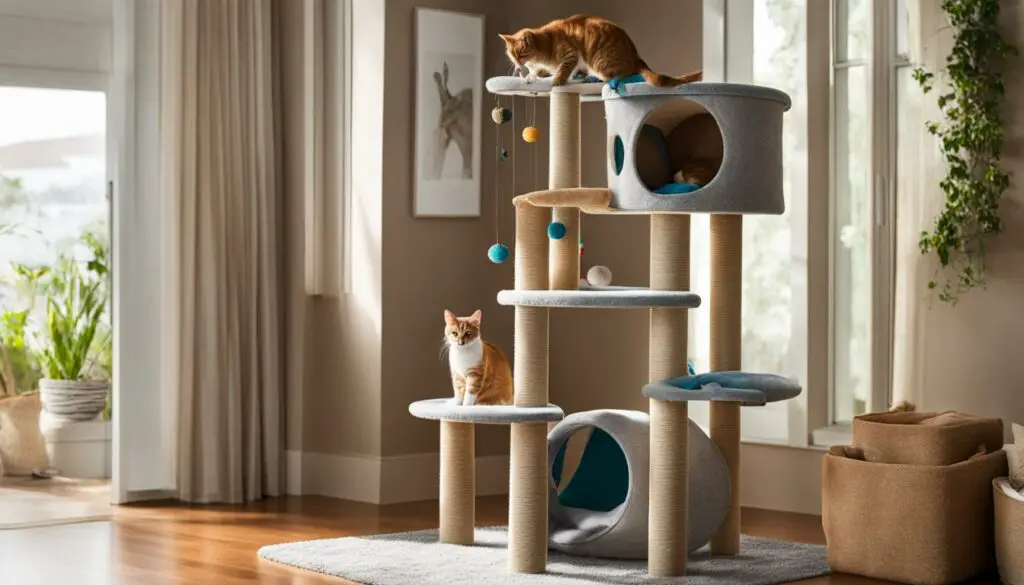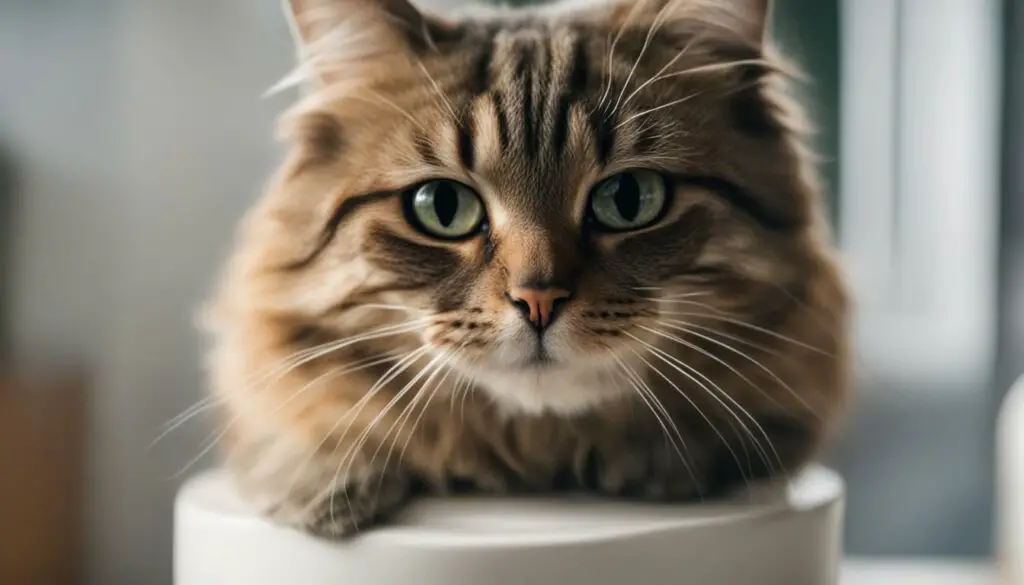Many cat owners find themselves perplexed by their feline companions’ behavior. At times, it may seem like our cats are being downright jerks. But fear not, fellow cat lover! In this article, I will delve into the reasons behind why our cats sometimes exhibit challenging behaviors that make us wonder, “Why is my cat an asshole?”
Key Takeaways:
- Cats‘ challenging behaviors are not intentional acts of being mean or difficult, but rather natural instincts and environmental factors at play.
- Cats form deep and secure attachments to their human caregivers, relying on them for comfort and security.
- Cats express love and affection through various behaviors such as purring, head-butting, grooming, and slow blinking.
- A cat’s behavior can be influenced by their owner’s personality, with anxious owners potentially experiencing more behavior problems.
- Understanding a cat’s facial expressions and body language can help owners better comprehend their feline friend’s emotions.
Understanding Cat Behavior Problems
Cats are beloved companions, but they can sometimes exhibit behavior problems that leave their owners scratching their heads. Understanding these problems is crucial for creating a harmonious household. From hyperactivity to destructiveness and nocturnal antics, cats can display a range of challenging behaviors.
It’s important to remember that these behaviors are not a result of cats intentionally being difficult or mean. Instead, they often stem from natural instincts and environmental factors. Neutering may not always eliminate these behavior problems, so it’s essential to delve deeper into understanding why they occur.
Cat behavior problems can arise due to various reasons. Some cats may need more mental and physical stimulation to satisfy their natural instincts. Others may exhibit destructive behaviors as a result of boredom or underlying medical issues. By recognizing the root causes and addressing them effectively, cat owners can help their feline friends lead happier and healthier lives.
To gain a better understanding of cat behavior problems, let’s explore some common issues and their possible explanations in the table below:
| Behavior Problem | Possible Explanations |
|---|---|
| Hyperactivity | Lack of mental and physical stimulation, excess energy |
| Destructiveness | Boredom, lack of appropriate toys or scratching posts |
| Nocturnal Antics | Natural hunting instincts, lack of sleep routine |
Understanding the reasons behind these behavior problems is the first step towards finding suitable solutions. In the following sections, we will explore strategies for addressing cat behavior problems, such as bonding with your cat, providing environmental enrichment, and seeking professional help when needed.
The Feline-Human Bond
Scientific research has shown that cats form deep and secure attachments to their human caregivers. Cats display attachment behavior, similar to how human children attach to their parents. This bond is based on communication and understanding, and cats rely on their humans for comfort and security.
Cats exhibit various behaviors that demonstrate their bond with humans. They will often seek out their owners for physical affection, such as rubbing against their legs or curling up next to them. These actions not only indicate a desire for physical contact but also serve as a way for cats to mark their owners with their scent, further strengthening the bond.
Additionally, cats communicate with their humans through vocalizations, body language, and facial expressions. They may meow, purr, or chirp to initiate interaction or convey their needs. By responding to these cues and providing care and attention, humans can foster a deeper connection with their feline companions.
Understanding Cat-Human Relationships
The feline-human bond is a mutual relationship that benefits both parties. For humans, interacting with cats can reduce stress and promote feelings of well-being. It has been observed that spending time with cats can lower blood pressure and release oxytocin, a hormone associated with bonding and relaxation.
On the other hand, cats rely on their humans for socialization, mental stimulation, and a sense of security. They feel safer and more comfortable when they have a reliable caregiver who meets their physical and emotional needs. This bond can help reduce anxiety and promote overall happiness in cats.
In conclusion, the feline-human bond is a special connection based on trust, communication, and care. Understanding and nurturing this bond is essential for both the well-being of cats and the satisfaction of their human companions.
Cats’ Expression of Love
When it comes to expressing love, cats have their own unique ways of showing affection towards their human companions. Despite their sometimes aloof demeanor, cats are capable of forming deep emotional bonds. Understanding how cats express their love can strengthen the feline-human relationship and provide insight into their feelings.
One of the most common ways cats show their love is through purring. The gentle rumbling sound signifies contentment and relaxation. When your cat curls up next to you and starts purring, it’s their way of saying they feel safe and secure in your presence.
Another sign of affection is head-butting, also known as bunting. Cats have scent glands located on their faces, and when they rub their heads against you, they are marking you with their scent. This behavior is a way of claiming you as part of their territory and expressing their bond.
Additionally, cats often groom themselves meticulously, and they may extend this behavior to their human companions. If your cat licks you gently or nibbles on your fingers, it’s a sign of affection and trust. Grooming is a social bonding behavior that strengthens the connection between cats and their loved ones.
Cats Recognize Their Names
Contrary to popular belief, cats recognize their names and respond when called. Research has shown that cats can differentiate their names from other words or sounds. However, their response may vary depending on their individual personality and level of training.
While cats may not come running to you every time you call their name, they often show subtle signs of recognition. They may prick their ears, turn their head toward you, or make eye contact when you call them. Cats are known for their independent nature, but they still appreciate the attention and interaction with their owners.
Building a strong bond and understanding your cat’s unique way of expressing love can deepen your relationship and create a sense of mutual trust and affection. Whether it’s through purring, head-butting, grooming, or recognizing their names, cats have their own language of love that is worth paying attention to.
The Influence of Human Personality
Understanding a cat’s behavior involves considering various factors, including the influence of their human caregivers’ personality. Research suggests that a cat’s behavior can be shaped by the characteristics and temperament of their owner. Cats are highly attuned to their environment and can sense the emotions and energy of their human companions.
Owners with anxious or neurotic personalities may unintentionally contribute to their cat’s behavior problems. Cats can pick up on their owner’s stress and anxiety, leading to increased aggression, fear, or other challenging behaviors. On the other hand, cats of owners with positive personality attributes tend to be more relaxed, confident, and outgoing.
To create a harmonious living environment for both you and your cat, it is important to be aware of your own personality traits and how they may influence your cat’s behavior. Recognizing and managing your own stress levels can help mitigate any negative impact on your cat’s well-being. Providing a calm and stable environment can also contribute to a more positive and relaxed feline companion.
Recognizing Cat’s Face and Body Language
Understanding the subtle cues of a cat’s face and body language can provide valuable insight into their emotions and behaviors. By paying close attention to their visual signals, cat owners can develop a deeper understanding of their feline companions. Here are some key aspects to be aware of:
| Facial Expressions | Body Language |
|---|---|
| Eyes: Cats‘ eyes can reveal a lot about their mood. Dilated pupils often indicate excitement or fear, while constricted pupils may suggest aggression or stress. Slow blinking is a sign of contentment and trust. |
Tail: A cat’s tail is a crucial part of their communication. A raised tail usually signifies a friendly and confident cat, while a tucked tail indicates fear or submission. Tail flicking or lashing can indicate agitation or annoyance. |
| Ears: The position of a cat’s ears can give insight into their emotional state. Erect ears indicate alertness and curiosity, while flattened ears can indicate fear, aggression, or discomfort. |
Whiskers: Whiskers play a significant role in a cat’s sensory perception. Forward-facing whiskers suggest curiosity or interest, while flattened whiskers can indicate fear or aggression. |
| Mouth: A relaxed and slightly open mouth is often a sign of contentment. Yowling or hissing with bared teeth may indicate aggression or fear. |
Posture: A cat’s overall body posture can reveal their emotional state. A relaxed and loose body suggests contentment, while a hunched or tense body may indicate fear or aggression. |
Recognizing these visual cues can help cat owners better understand and respond to their cats’ needs. However, it’s important to remember that each cat is unique, and their body language may vary slightly. Taking the time to observe and learn your cat’s individual expressions and behaviors will foster a stronger bond and enhance your overall relationship.
Tips for Bonding With Your Cat
Bonding with your cat is a rewarding experience that can strengthen your relationship and create a deeper understanding between you and your feline friend. Here are some tips to help you build a strong bond with your cat:
- Spend quality time together: Set aside dedicated playtime each day to interact with your cat. Use toys that stimulate their natural instincts, such as feather wands or laser pointers. Engage in interactive play to keep them mentally and physically stimulated.
- Provide social interaction: Cats are social animals and enjoy human companionship. Talk to your cat, pet them gently, and give them affectionate scratches behind the ears or under the chin. Show them that you enjoy their company.
- Listen to your cat’s needs: Cats communicate in various ways, so pay attention to their body language and vocalizations. Respect their boundaries and provide them with a safe and comfortable environment where they can retreat when needed.
Remember, building a bond with your cat takes time and patience. Every cat is unique, so be patient and understanding as you develop your relationship. Trust and mutual respect are key to fostering a strong bond.
Creating a Stimulating Environment
In addition to spending quality time together, creating a stimulating environment is important for bonding with your cat. Provide them with the following:
- Scratching posts: Cats have a natural instinct to scratch, so providing them with appropriate scratching posts will help satisfy this behavior and prevent them from damaging furniture.
- Climbing trees or perches: Cats love to climb and perch in high places. Install shelves, cat trees, or towers to give them vertical space and opportunities for exploration.
- Interactive toys: Keep your cat engaged with puzzle toys and treat dispensers that challenge their problem-solving skills. This will provide mental stimulation and keep them entertained.
By creating a stimulating environment, you’ll be providing your cat with outlets for their natural behaviors and keeping them mentally and physically active.
Respecting Personal Space
Respecting your cat’s personal space is crucial for building trust and a positive relationship. Avoid forcing interactions or overwhelming them with too much attention. Give your cat the choice to approach you when they are ready for affection and companionship.
It’s important to note that some cats are more independent and may not seek as much physical contact as others. Respect their preferences and provide them with the space they need, while still offering opportunities for social interaction and play.
Remember, every cat is unique, and the bond you form with your feline companion will be based on mutual understanding, trust, and respect. By following these tips, you’ll be on your way to building a strong and meaningful connection with your cat.

Addressing Cat’s Destructive Behavior
Managing aggressive cats or dealing with destructive behavior can be challenging for cat owners. It is important to understand the underlying reasons behind these behaviors and find suitable solutions to redirect your cat’s energy and prevent further damage. Here are some strategies to address cat aggression and manage destructive behavior:
Create a Safe and Enriched Environment
Provide your cat with a stimulating environment that includes scratching posts, climbing trees, interactive toys, and hiding spots. These enrichments can reduce boredom and redirect your cat’s destructive tendencies to appropriate outlets. Vertical spaces and opportunities for play and exploration can significantly improve your cat’s behavior and overall happiness.
Implement Structured Play Sessions
Regular play sessions are essential for cats to release energy and engage in natural hunting behaviors. Use interactive toys that mimic prey, such as feather wands or laser pointers, and engage in play with your cat. This helps satisfy their natural instincts and provides an appropriate outlet for their energy. Ending play sessions with a meal can also mimic the natural hunting sequence, further satisfying their needs.
Consult with a Veterinary Professional
If your cat’s aggressive behavior persists or becomes a safety concern, it is crucial to consult with a veterinarian or an animal behaviorist. These professionals can assess your cat’s behavior, rule out any underlying medical issues, and provide specific advice tailored to your cat’s individual needs. They may recommend behavior modification techniques, medications, or additional interventions to address the aggression or destructive behavior effectively.
By addressing your cat’s destructive behavior and managing aggression, you can create a safer and more harmonious environment for both you and your feline companion. Remember, it takes time, patience, and consistency to see positive changes, so don’t get discouraged if progress is gradual. With the right approach and professional guidance, you can help your cat overcome their challenging behaviors and foster a stronger bond.

Tips for Handling a Challenging Cat and Cat Behavior Modification
Dealing with a challenging cat can be frustrating and overwhelming at times. However, with some patience, understanding, and effective behavior modification techniques, you can help improve your cat’s behavior and create a more harmonious environment for both of you.
Establish a Routine
Setting a consistent routine can be beneficial for cats, especially those with nocturnal tendencies. Establish a regular play and feeding schedule to help channel their energy and encourage a more restful sleep at night. By providing mental and physical stimulation during the day, you can help reduce their need for nighttime antics.
Use Positive Reinforcement
Positive reinforcement is key when it comes to modifying your cat’s behavior. Reward and praise your cat for desired behaviors, such as using a scratching post instead of furniture or being calm during grooming sessions. By reinforcing good behavior, you can help redirect their attention away from destructive or aggressive tendencies.
Provide Environmental Enrichment
One of the reasons cats may exhibit challenging behavior is because they’re bored or lack stimulation. Ensure your cat has plenty of toys, scratching posts, and interactive puzzles to keep them mentally and physically engaged. Creating a stimulating environment can help prevent boredom and destructive behaviors.
| Tip | Description |
|---|---|
| Provide vertical space | Cats love to climb and perch in high places. Install cat trees or shelves to give them vertical space to explore and observe their surroundings. |
| Offer hiding spots | Cats need a safe place to retreat when they feel overwhelmed or stressed. Provide hiding spots such as covered beds or boxes where they can feel secure. |
| Rotate toys | Keep your cat’s toys interesting by rotating them regularly. This helps prevent boredom and keeps them engaged with their playthings. |
Remember, each cat is unique, and what works for one may not work for another. It’s important to observe your cat’s individual needs and behavior patterns to tailor your approach to their specific challenges. If you’re struggling to handle your cat’s behavior on your own, consider consulting with a professional cat behaviorist who can provide specialized guidance and support.

Setting Boundaries and Training
As a cat owner, I understand the importance of setting boundaries and training to ensure a harmonious relationship with our feline friends. Training cats may seem daunting, but with patience, consistency, and positive reinforcement, it is possible to teach them to understand boundaries and follow basic commands. By doing so, we can prevent unwanted behaviors and foster a well-behaved and happy cat.
Why is cat training important?
Cat training is essential for several reasons. It allows us to establish clear boundaries and communicate our expectations to our cats. This not only prevents destructive behaviors like scratching furniture or spraying but also helps keep them safe. For example, teaching cats to come when called can prevent them from wandering off or getting into dangerous situations.
Training also provides mental stimulation for cats, which is crucial for their overall well-being. It keeps them engaged, prevents boredom, and enhances their cognitive abilities. Additionally, training strengthens the bond between cats and their owners, as it allows for positive interactions and mutual understanding.
To train your cat effectively, focus on positive reinforcement techniques. Reward desired behaviors with treats, praise, or playtime, while ignoring or redirecting unwanted behaviors. Clicker training can also be a useful tool in shaping your cat’s behavior. Remember to be patient and provide consistent training sessions in short intervals, as cats have shorter attention spans compared to dogs.

| Training Tips | Benefits |
|---|---|
| Use treats as rewards | Reinforces positive behavior |
| Keep training sessions short and frequent | Prevents boredom and maintains focus |
| Focus on one behavior at a time | Allows for clear communication |
| Use a clicker for timing and consistency | Aids in communication and reinforcement |
| Be patient and avoid punishment | Builds trust and a positive relationship |
Remember, each cat is unique, and training progress may vary. Be flexible and adapt your approach to suit your cat’s individual personality and learning style. Celebrate small victories and keep training sessions fun and enjoyable for both you and your feline companion.
The Importance of Environmental Enrichment
Cats are curious and intelligent creatures that thrive in environments that provide mental and physical stimulation. Environmental enrichment plays a vital role in preventing cat behavior problems and ensuring their overall well-being. By creating a stimulating environment, cat owners can help their feline friends live happier and healthier lives.
Creating a Stimulating Environment
One of the key aspects of environmental enrichment is providing cats with opportunities for play, exploration, and exercise. This can be achieved by offering a variety of interactive toys that mimic natural prey, such as feather wands, puzzle feeders, and treat-dispensing toys. Additionally, providing scratching posts, climbing trees, and perches allows cats to engage in their natural behaviors and provides them with vertical space to explore and observe their surroundings.
It is also important to consider the sensory needs of cats. Providing different textures, such as soft bedding, cardboard boxes, and sisal scratching surfaces, can fulfill their tactile needs. Additionally, offering hiding spots and elevated resting areas can give cats a sense of security and allow them to retreat when they need some alone time.
The Benefits of Environmental Enrichment
By enriching their environment, cats are less likely to exhibit problem behaviors such as inappropriate scratching, aggression, or excessive vocalization. Environmental enrichment provides cats with the mental and physical stimulation they need, which can help prevent boredom and frustration. It also helps redirect their energy towards more appropriate outlets, reducing the likelihood of destructive behaviors.
Furthermore, a stimulating environment enhances the overall quality of life for cats. It allows them to engage in their natural behaviors, provides mental stimulation, and promotes physical exercise. This can contribute to better physical health, weight management, and a reduction in stress-related behaviors.
| Benefits of Environmental Enrichment: | Examples: |
|---|---|
| Prevents boredom and frustration | Interactive toys and puzzle feeders |
| Reduces destructive behaviors | Scratching posts and climbing trees |
| Enhances overall quality of life | Hiding spots and elevated resting areas |

Providing a stimulating environment is essential for maintaining a happy and well-adjusted cat. By incorporating various elements of environmental enrichment into their living space, cat owners can help prevent behavior problems and ensure their furry companions lead fulfilling lives.
Maintaining a Calm and Stress-Free Environment
As responsible cat owners, it is essential for us to create a calm and stress-free environment for our feline companions. Cats are highly sensitive creatures and can easily become anxious or stressed when exposed to certain triggers. By taking a few simple steps, we can help reduce cat stress and aggression, improving their overall well-being.
Identifying Stressors
To effectively manage cat stress, it is important to identify the specific stressors that may be causing your cat’s anxious behavior. Common stressors include changes in the household routine, loud noises, unfamiliar visitors, or even conflicts with other pets. By recognizing these triggers, we can take proactive measures to minimize their impact on our cats’ emotional state.
Creating a Safe Retreat
One effective way to reduce cat stress is by providing a designated safe retreat for your cat. This can be a cozy corner of the house where they can retreat to when they feel overwhelmed or anxious. Fill this area with soft bedding, toys, and comforting scents like lavender or catnip. Ensuring that your cat has a quiet and secure space to escape to can help them feel more at ease.
| Stressor | Solution |
|---|---|
| Loud Noises | Provide a quiet and secluded area for your cat to retreat to during loud events or construction work. |
| Changes in Routine | Stick to a consistent schedule for feeding, playtime, and sleep to provide stability and reduce anxiety. |
| Conflict with Other Pets | Introduce pets slowly and gradually, using positive reinforcement techniques to promote harmony. |
Calming Pheromones
Calming pheromone sprays or diffusers can be effective tools in maintaining a stress-free environment for your cat. These products mimic the natural pheromones that cats release when they feel safe and secure. By dispersing calming scents throughout the home, we can help create a soothing atmosphere that promotes relaxation and reduces anxiety.
By implementing these strategies, we can create a calm and stress-free environment for our cats, ensuring their overall well-being and happiness. Remember, a relaxed and content cat is a happy cat!
Seeking Professional Help
While understanding and addressing challenging behaviors in cats is possible for many owners, there may be instances where seeking professional help is necessary. A certified cat behaviorist or a veterinarian specializing in behavior can provide expert guidance and tailored solutions for your specific situation. They have the knowledge and experience to assess your cat’s behavior, identify underlying causes, and develop a comprehensive behavior modification plan.
Professional cat behaviorists are skilled in interpreting feline behavior and can help you understand why your cat is behaving the way it is. They will conduct a thorough evaluation of your cat’s environment, daily routine, and interactions with family members. By identifying any triggers or stressors, they can devise strategies to address and modify the problematic behavior.
Veterinarians specializing in behavior can also play a crucial role in managing and modifying cat behavior issues. They will assess your cat’s overall health and determine if there are any medical conditions contributing to the behavior problems. They may recommend specific treatments or medications to alleviate any underlying medical issues that could be influencing your cat’s behavior.
Rather than relying on anecdotal advice or inconsistent online sources, consulting with professionals will ensure that you receive accurate information and effective strategies. They can provide you with practical techniques, training exercises, and resources tailored to your cat’s individual needs. Remember, seeking professional help is not a sign of failure as a cat owner but a proactive step towards improving your cat’s well-being and your relationship with them.
Table: Differences Between Cat Behaviorist and Veterinary Behaviorist
| Cat Behaviorist | Veterinary Behaviorist | |
|---|---|---|
| Education and Training | Specialized training in feline behavior and psychology | Qualified veterinarian with additional training in behavior |
| Focus | Behavior modification, environmental enrichment, and training | Behavioral issues and medical conditions affecting behavior |
| Assessment | Evaluates cat’s behavior, environment, and interactions | Assesses cat’s overall health and investigates medical causes |
| Treatment | Develops behavior modification plans and provides training guidance | Prescribes medication, offers medical interventions, and behavior modification plans |
| Team Collaboration | Works with your veterinarian to ensure holistic care | Collaborates with veterinary specialists and other medical professionals |
Whether you choose to consult a cat behaviorist or a veterinary behaviorist, it is important to ensure they are certified or accredited in their respective fields. Check their credentials, reviews from previous clients, and ask for recommendations from trusted sources. Building a team of professionals who understand cat behavior can provide you with the support and guidance needed to address your cat’s behavior challenges effectively.

Remember, seeking professional help is not a sign of failure as a cat owner but a proactive step towards improving your cat’s well-being and your relationship with them.
Understanding Challenging Behaviors in Cats
Have you ever wondered why your beloved feline companion sometimes behaves like, well, an asshole? Rest assured, you are not alone. Many cat owners encounter challenging behaviors in their furry friends that can leave them feeling frustrated and confused. In this section, we will explore some of the reasons behind these behaviors and shed light on the complexities of feline psychology.
Misunderstood Instincts and Natural Behaviors
Before labeling your cat as an asshole, it’s important to understand that many of their actions stem from their natural instincts. Cats are born hunters, and behaviors such as scratching, pouncing, and play aggression are all part of their innate repertoire. These instincts may manifest in ways that appear destructive or aggressive, but they are simply the result of your cat’s primal nature.
Additionally, cats are highly territorial creatures, and they may exhibit behaviors like hissing, swatting, or spraying urine to mark their territory. While these actions can be frustrating for owners, they serve as a means of communication and boundary-setting for our feline friends.
Environmental Factors and Stress
Just like humans, cats can experience stress and anxiety, which can contribute to challenging behaviors. Changes in their environment, such as moving to a new home, introducing a new pet, or disruptions in their daily routine, can trigger stress in cats. This stress may manifest as aggressive or destructive behaviors as your cat tries to cope with the unfamiliar situation.
In addition, boredom and lack of mental stimulation can also lead to negative behaviors in cats. Cats are intelligent animals that require mental and physical stimulation to thrive. Without appropriate outlets for their energy, they may resort to destructive actions or seeking attention in undesirable ways.
Individual Personality and Communication
It’s essential to remember that each cat is unique and has their own distinct personality. Some cats may naturally be more mischievous or independent, while others are more affectionate and easygoing. Understanding and accepting your cat’s individuality is key to building a strong and harmonious relationship.
Moreover, cats communicate in their own subtle ways, using body language, vocalizations, and other cues to express their needs and emotions. By learning to recognize and interpret these signals, you can better understand your cat’s intentions and avoid potential misunderstandings.
Remember, while challenging behaviors in cats can be frustrating, they are often rooted in natural instincts, environmental factors, and individual personality traits. By providing a stimulating environment, addressing stressors, and fostering clear communication, you can help your cat navigate their world in a more positive and balanced way.
Understanding Cat Behavior Problems: A Closer Look at Cat Aggression
As a cat owner, it’s not uncommon to encounter behavior problems with your feline companion. One of the most puzzling and frustrating issues is cat aggression. Understanding the reasons behind cat aggression is the first step in effectively managing and modifying this behavior.
Cat aggression can stem from various factors, including fear, territorial instincts, or redirected aggression. It’s important to recognize that aggressive behavior is not always a sign of a mean-spirited or “asshole” cat. Cats are complex creatures, and their aggressive actions are often a result of their natural instincts and past experiences.
When faced with cat aggression, it’s crucial to approach the issue with patience and empathy. By observing and analyzing the triggers for your cat’s aggression, you can better understand their perspective and tailor your response accordingly. Seeking professional advice from a cat behaviorist or veterinarian specializing in behavior can provide valuable insights and guidance specific to your cat’s unique situation.
Remember, cat behavior problems, including aggression, can be managed and modified with the right approach. By creating a safe and enriched environment, providing mental and physical stimulation, and seeking professional help when needed, you can foster a harmonious relationship with your feline friend and help them lead a happy, stress-free life.
FAQ
Why does my cat exhibit challenging behaviors?
Cats may exhibit challenging behaviors due to natural instincts and environmental factors.
Do cats show love and affection towards their owners?
Yes, cats show love through behaviors such as purring, head-butting, grooming, and slow blinking.
Can my personality influence my cat’s behavior?
Yes, research suggests that a cat’s behavior can be influenced by their owner’s personality.
How can I understand my cat’s emotions?
Cats communicate their feelings through facial expressions and body language.
How can I build a strong bond with my cat?
Spending quality playtime together and providing social interaction can help strengthen your bond with your cat.
How can I address my cat’s destructive behaviors?
Providing appropriate toys, environmental enrichment, and structured play sessions can help redirect your cat’s energy and prevent destructive behaviors.
What can I do to reduce my cat’s nocturnal antics?
Establishing a regular play and feeding schedule and creating a calming bedtime routine can help reduce your cat’s nocturnal antics.
Can cats be trained?
Yes, cats can be trained using positive reinforcement techniques such as rewards and clicker training.
How can I provide a stimulating environment for my cat?
Enriching your cat’s environment with scratching posts, climbing trees, interactive toys, and hiding spots can prevent boredom and destructive behaviors.
How can I create a stress-free environment for my cat?
Minimizing sudden changes and providing hiding places and a safe retreat can help reduce stress and anxiety in cats.
When should I seek professional help for my cat’s behavior issues?
If you are experiencing persistent cat behavior issues, it is advisable to seek professional help from a certified cat behaviorist or veterinarian specializing in behavior.
How can I manage and modify challenging cat behaviors?
Understanding the reasons behind your cat’s behavior, promoting a strong bond, providing environmental enrichment, and seeking professional help when necessary can help manage and modify challenging cat behaviors.








